INFINITI QX30 2018 Owners Manual
Manufacturer: INFINITI, Model Year: 2018, Model line: QX30, Model: INFINITI QX30 2018Pages: 538, PDF Size: 3.79 MB
Page 421 of 538
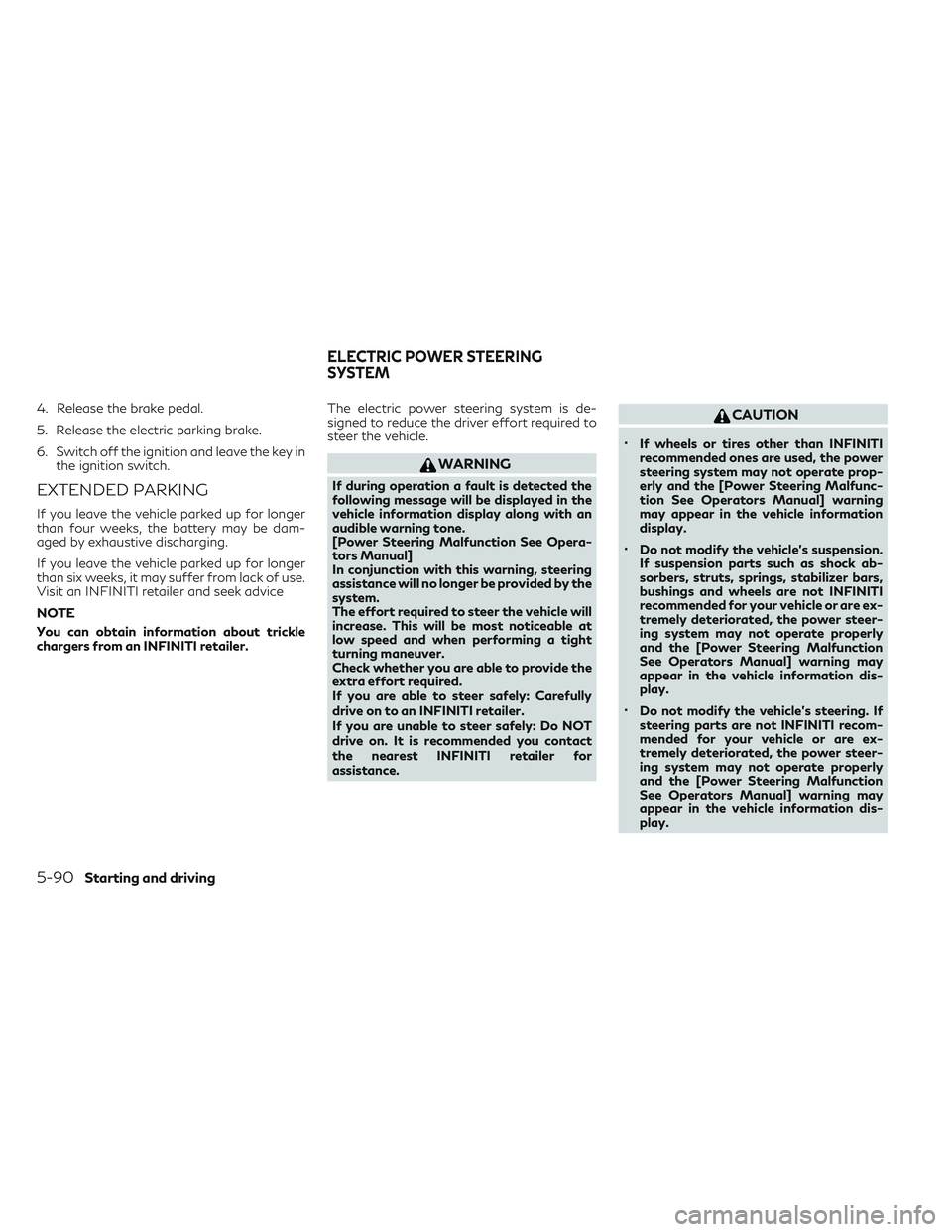
4. Release the brake pedal.
5. Release the electric parking brake.
6. Switch off the ignition and leave the key inthe ignition switch.
EXTENDED PARKING
If you leave the vehicle parked up for longer
than four weeks, the battery may be dam-
aged by exhaustive discharging.
If you leave the vehicle parked up for longer
than six weeks, it may suffer from lack of use.
Visit an INFINITI retailer and seek advice
NOTE
You can obtain information about trickle
chargers from an INFINITI retailer. The electric power steering system is de-
signed to reduce the driver effort required to
steer the vehicle.
WARNING
If during operation a fault is detected the
following message will be displayed in the
vehicle information display along with an
audible warning tone.
[Power Steering Malfunction See Opera-
tors Manual]
In conjunction with this warning, steering
assistance will no longer be provided by the
system.
The effort required to steer the vehicle will
increase. This will be most noticeable at
low speed and when performing a tight
turning maneuver.
Check whether you are able to provide the
extra effort required.
If you are able to steer safely: Carefully
drive on to an INFINITI retailer.
If you are unable to steer safely: Do NOT
drive on. It is recommended you contact
the nearest INFINITI retailer for
assistance.
CAUTION
•If wheels or tires other than INFINITI
recommended ones are used, the power
steering system may not operate prop-
erly and the [Power Steering Malfunc-
tion See Operators Manual] warning
may appear in the vehicle information
display.
•Do not modify the vehicle's suspension.
If suspension parts such as shock ab-
sorbers, struts, springs, stabilizer bars,
bushings and wheels are not INFINITI
recommended for your vehicle or are ex-
tremely deteriorated, the power steer-
ing system may not operate properly
and the [Power Steering Malfunction
See Operators Manual] warning may
appear in the vehicle information dis-
play.
•Do not modify the vehicle's steering. If
steering parts are not INFINITI recom-
mended for your vehicle or are ex-
tremely deteriorated, the power steer-
ing system may not operate properly
and the [Power Steering Malfunction
See Operators Manual] warning may
appear in the vehicle information dis-
play.
ELECTRIC POWER STEERING
SYSTEM
5-90Starting and driving
Page 422 of 538

•Do not place the ignition switch in the on
position while the steering wheel or a
tire is removed.
•Do not turn the steering wheel as much
as possible while the ignition switch is in
any position other than the ON position.
•Installing an accessory on the steering
wheel, or changing the steering wheel,
may reduce the steering performance.
NOTE
When the steering wheel is operated repeat-
edly or continuously while parking or driving
at a very low speed, the power assistance for
the steering wheel will be reduced. This is to
prevent overheating of the electric power
steering system and protect it from becom-
ing damaged. While the power assistance is
reduced, steering wheel operation will be-
come heavy. When the temperature of the
electric power steering system decreases,
the power assistance level will return to nor-
mal. Avoid repeating such steering wheel
operations that could cause the electric
power steering system to overheat. The brake system has two separate hydraulic
circuits. If one circuit malfunctions, you will
still have braking ability at two wheels.
BRAKE PRECAUTIONS
WARNING
While driving on a slippery surface, be
careful when braking, accelerating or
downshifting. Abrupt braking or acceler-
ating could cause the wheels to skid and
result in an accident.
Vacuum assisted brakes
The brake booster aids braking by using en-
gine vacuum. If the engine stops, you can
stop the vehicle by depressing the brake
pedal. However, greater foot pressure on the
brake pedal will be required to stop the ve-
hicle. The stopping distance will be longer.
WARNING
•If the engine is not running or is turned
off while driving, the power assist for
the brakes will not work. Braking will be
harder.
•Do not coast with the engine stopped. When the brake pedal is depressed slowly
and firmly, you may hear a clicking noise and
feel a slight pulsation. This is normal and
indicates that the Brake Assist System is op-
erating (if equipped).
Using brakes
Avoid resting your foot on the brake pedal
while driving. This will overheat the brakes,
wear out the brake linings/pads faster, and
increase fuel consumption.
To help reduce brake wear and to prevent the
brakes from overheating, reduce speed and
downshift to a lower gear before going down
a slope or long grade. Overheated brakes
may reduce braking performance and could
result in loss of vehicle control.
While driving on a slippery surface, be careful
when braking, accelerating or downshifting.
Abrupt braking or acceleration could cause
the wheels to skid and result in an accident.
Wet brakes
When the vehicle is washed or driven through
water, the brakes may get wet. As a result,
your braking distance will be longer and the
vehicle may pull to one side during braking.
To dry the brakes, drive the vehicle at a safe
speed while lightly depressing the brake
pedal to heat up the brakes. Do this until the
brakes return to normal. Avoid driving the
BRAKE SYSTEM
Starting and driving5-91
Page 423 of 538

vehicle at high speeds until the brakes func-
tion correctly.
Driving uphill
When starting on a steep gradient, it is some-
times difficult to operate the brake. Use the
parking brake to hold the vehicle. When ready
to start, make sure that the shift lever is in an
appropriate forward or reverse driving posi-
tion, release the parking brake while depress-
ing the accelerator pedal. If your vehicle has
an electric parking brake, this will automati-
cally release when you depress the accelera-
tor pedal (DCT models).
Driving downhill
The engine braking action is effective for
controlling the vehicle while descending hills.
A low gear position in the manual shift mode,
low enough to obtain sufficient engine brak-
ing, should be selected.
Parking brake break-in
Break in the parking brake shoes whenever
the stopping effect of the parking brake is
weakened or whenever the parking brake
shoes and/or drums/rotors are replaced, in
order to assure the best braking perfor-
mance.This procedure is described in the vehicle ser-
vice manual and can be performed by an
INFINITI retailer.
ANTI-LOCK BRAKING SYSTEM
(ABS)
WARNING
The Anti-lock Braking System (ABS) is a
sophisticated device, but it cannot prevent
accidents resulting from careless or dan-
gerous driving techniques. It can help
maintain vehicle control during braking on
slippery surfaces. Remember that stopping
distances on slippery surfaces will be lon-
ger than on normal surfaces even with
ABS. Stopping distances may also be lon-
ger on rough, gravel or snow covered
roads, or if you are using tire chains. Al-
ways maintain a safe distance from the ve-
hicle in front of you. Ultimately, the driver
is responsible for safety.
Tire type and condition may also affect
braking effectiveness.
– When replacing tires, install the specified
size of tires on all four wheels.
– When installing a replacement tire, make
sure that it is the proper size and type as
specified on the tire and loading informa- tion label. (See "Wheels and Tires" in the
"9. Maintenance and Schedules" section.)
– For detailed information, see "Wheels and
tires" in the "8. Do-it-yourself" section.
The Anti-lock Braking System (ABS) controls
the brakes so the wheels do not lock during
hard braking or when braking on slippery sur-
faces. The system detects the rotation speed
at each wheel and varies the brake fluid pres-
sure to prevent each wheel from locking and
sliding. By preventing each wheel from lock-
ing, the system helps the driver maintain
steering control and helps to minimize swerv-
ing and spinning on slippery surfaces.
Using system
Depress the brake pedal and hold it down.
Depress the brake pedal with firm steady
pressure, but do not pump the brakes. The
ABS will operate to prevent the wheels from
locking up. Steer the vehicle to avoid ob-
stacles.
WARNING
Do not pump the brake pedal. Doing so may
result in increased stopping distances.
5-92Starting and driving
Page 424 of 538
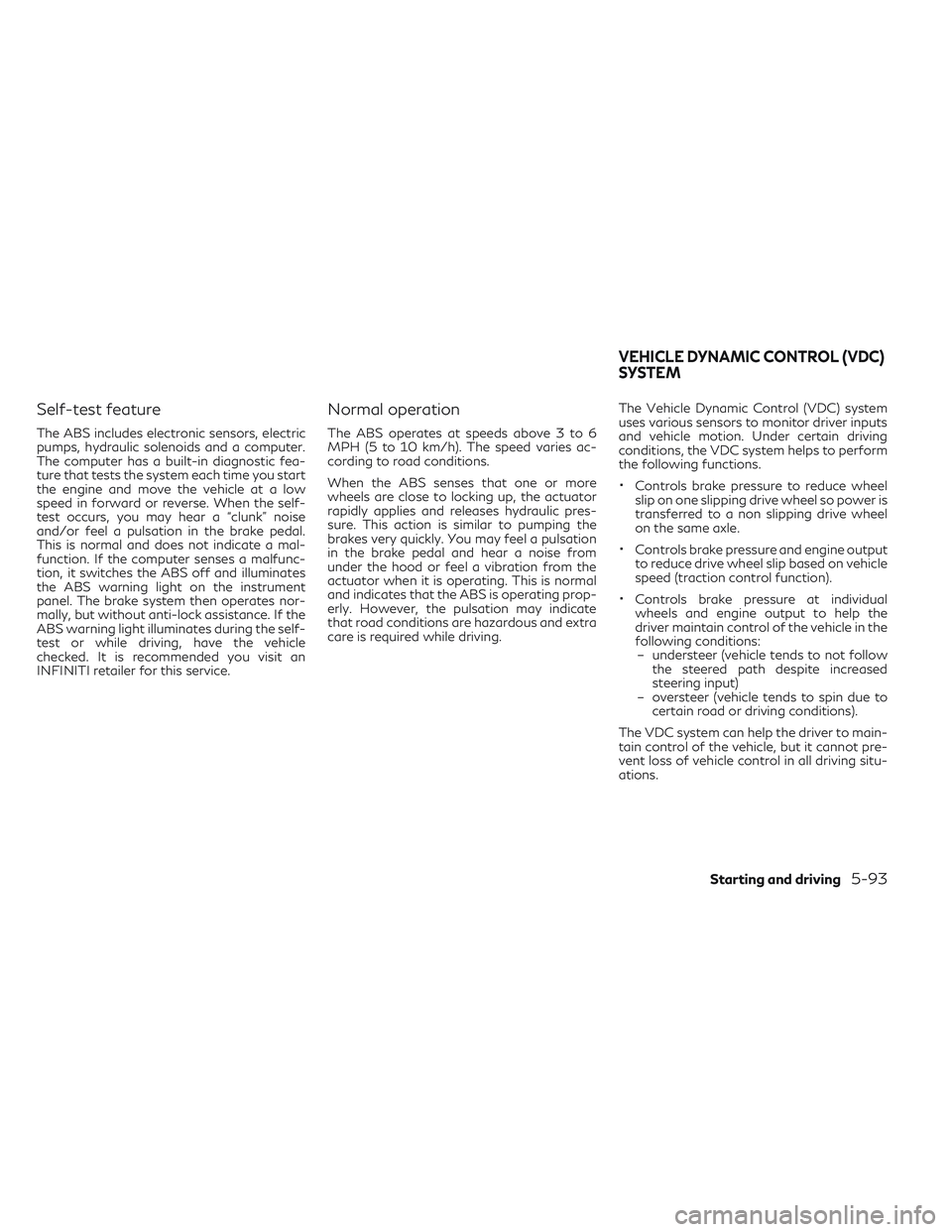
Self-test feature
The ABS includes electronic sensors, electric
pumps, hydraulic solenoids and a computer.
The computer has a built-in diagnostic fea-
ture that tests the system each time you start
the engine and move the vehicle at a low
speed in forward or reverse. When the self-
test occurs, you may hear a “clunk” noise
and/or feel a pulsation in the brake pedal.
This is normal and does not indicate a mal-
function. If the computer senses a malfunc-
tion, it switches the ABS off and illuminates
the ABS warning light on the instrument
panel. The brake system then operates nor-
mally, but without anti-lock assistance. If the
ABS warning light illuminates during the self-
test or while driving, have the vehicle
checked. It is recommended you visit an
INFINITI retailer for this service.
Normal operation
The ABS operates at speeds above 3 to 6
MPH (5 to 10 km/h). The speed varies ac-
cording to road conditions.
When the ABS senses that one or more
wheels are close to locking up, the actuator
rapidly applies and releases hydraulic pres-
sure. This action is similar to pumping the
brakes very quickly. You may feel a pulsation
in the brake pedal and hear a noise from
under the hood or feel a vibration from the
actuator when it is operating. This is normal
and indicates that the ABS is operating prop-
erly. However, the pulsation may indicate
that road conditions are hazardous and extra
care is required while driving.The Vehicle Dynamic Control (VDC) system
uses various sensors to monitor driver inputs
and vehicle motion. Under certain driving
conditions, the VDC system helps to perform
the following functions.
•Controls brake pressure to reduce wheel
slip on one slipping drive wheel so power is
transferred to a non slipping drive wheel
on the same axle.
•Controls brake pressure and engine output
to reduce drive wheel slip based on vehicle
speed (traction control function).
•Controls brake pressure at individual
wheels and engine output to help the
driver maintain control of the vehicle in the
following conditions: – understeer (vehicle tends to not follow the steered path despite increased
steering input)
– oversteer (vehicle tends to spin due to certain road or driving conditions).
The VDC system can help the driver to main-
tain control of the vehicle, but it cannot pre-
vent loss of vehicle control in all driving situ-
ations.
VEHICLE DYNAMIC CONTROL (VDC)
SYSTEM
Starting and driving5-93
Page 425 of 538
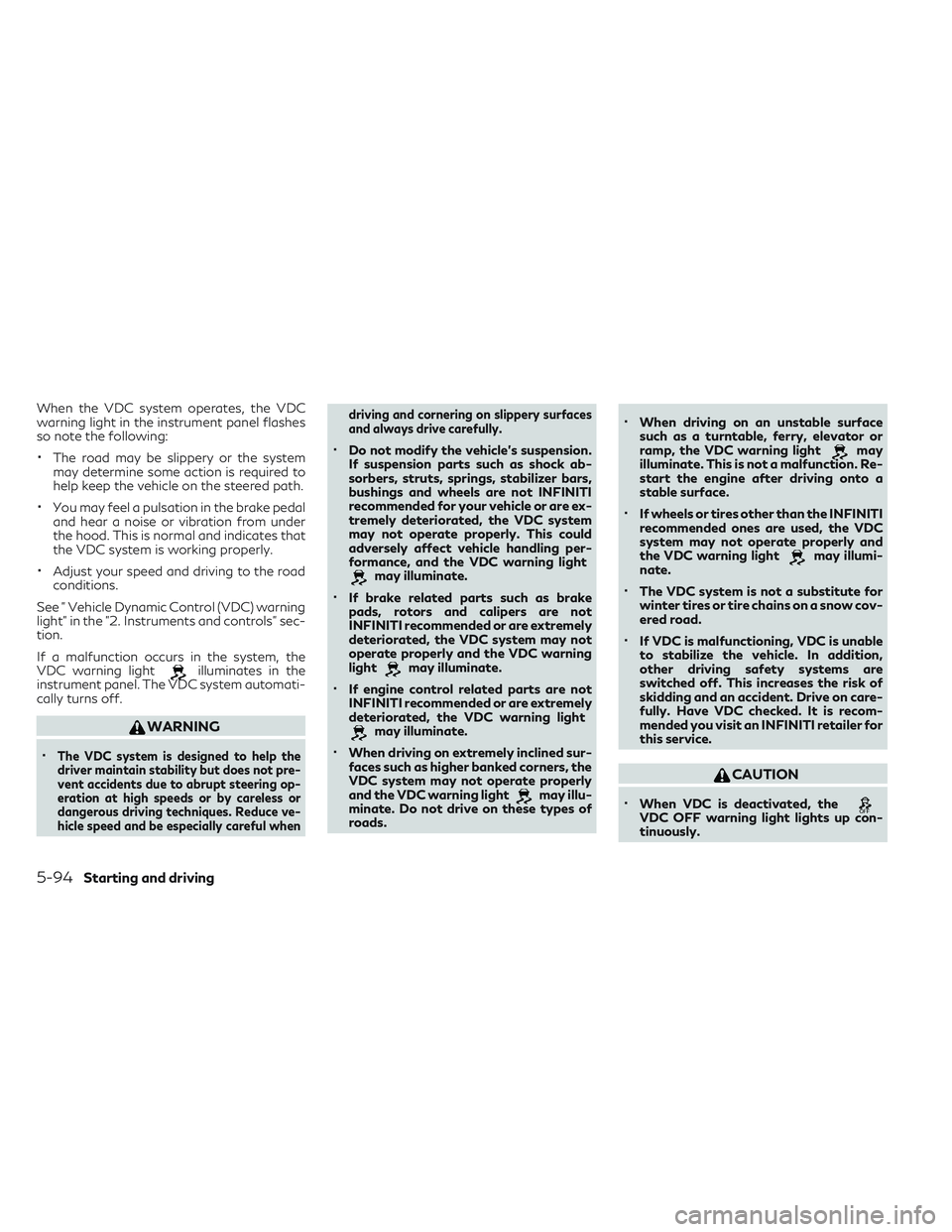
When the VDC system operates, the VDC
warning light in the instrument panel flashes
so note the following:
•The road may be slippery or the system
may determine some action is required to
help keep the vehicle on the steered path.
•You may feel a pulsation in the brake pedal
and hear a noise or vibration from under
the hood. This is normal and indicates that
the VDC system is working properly.
•Adjust your speed and driving to the road
conditions.
See " Vehicle Dynamic Control (VDC) warning
light" in the "2. Instruments and controls" sec-
tion.
If a malfunction occurs in the system, the
VDC warning light
illuminates in the
instrument panel. The VDC system automati-
cally turns off.
WARNING
•The VDC system is designed to help the
driver maintain stability but does not pre-
vent accidents due to abrupt steering op-
eration at high speeds or by careless or
dangerous driving techniques. Reduce ve-
hicle speed and be especially careful when driving and cornering on slippery surfaces
and always drive carefully.
•Do not modify the vehicle’s suspension.
If suspension parts such as shock ab-
sorbers, struts, springs, stabilizer bars,
bushings and wheels are not INFINITI
recommended for your vehicle or are ex-
tremely deteriorated, the VDC system
may not operate properly. This could
adversely affect vehicle handling per-
formance, and the VDC warning light
may illuminate.
•If brake related parts such as brake
pads, rotors and calipers are not
INFINITI recommended or are extremely
deteriorated, the VDC system may not
operate properly and the VDC warning
light
may illuminate.
•If engine control related parts are not
INFINITI recommended or are extremely
deteriorated, the VDC warning light
may illuminate.
•When driving on extremely inclined sur-
faces such as higher banked corners, the
VDC system may not operate properly
and the VDC warning light
may illu-
minate. Do not drive on these types of
roads.
•When driving on an unstable surface
such as a turntable, ferry, elevator or
ramp, the VDC warning light
may
illuminate. This is not a malfunction. Re-
start the engine after driving onto a
stable surface.
•If wheels or tires other than the INFINITI
recommended ones are used, the VDC
system may not operate properly and
the VDC warning light
may illumi-
nate.
•The VDC system is not a substitute for
winter tires or tire chains on a snow cov-
ered road.
•If VDC is malfunctioning, VDC is unable
to stabilize the vehicle. In addition,
other driving safety systems are
switched off. This increases the risk of
skidding and an accident. Drive on care-
fully. Have VDC checked. It is recom-
mended you visit an INFINITI retailer for
this service.
CAUTION
•When VDC is deactivated, theVDC OFF warning light lights up con-
tinuously.
5-94Starting and driving
Page 426 of 538
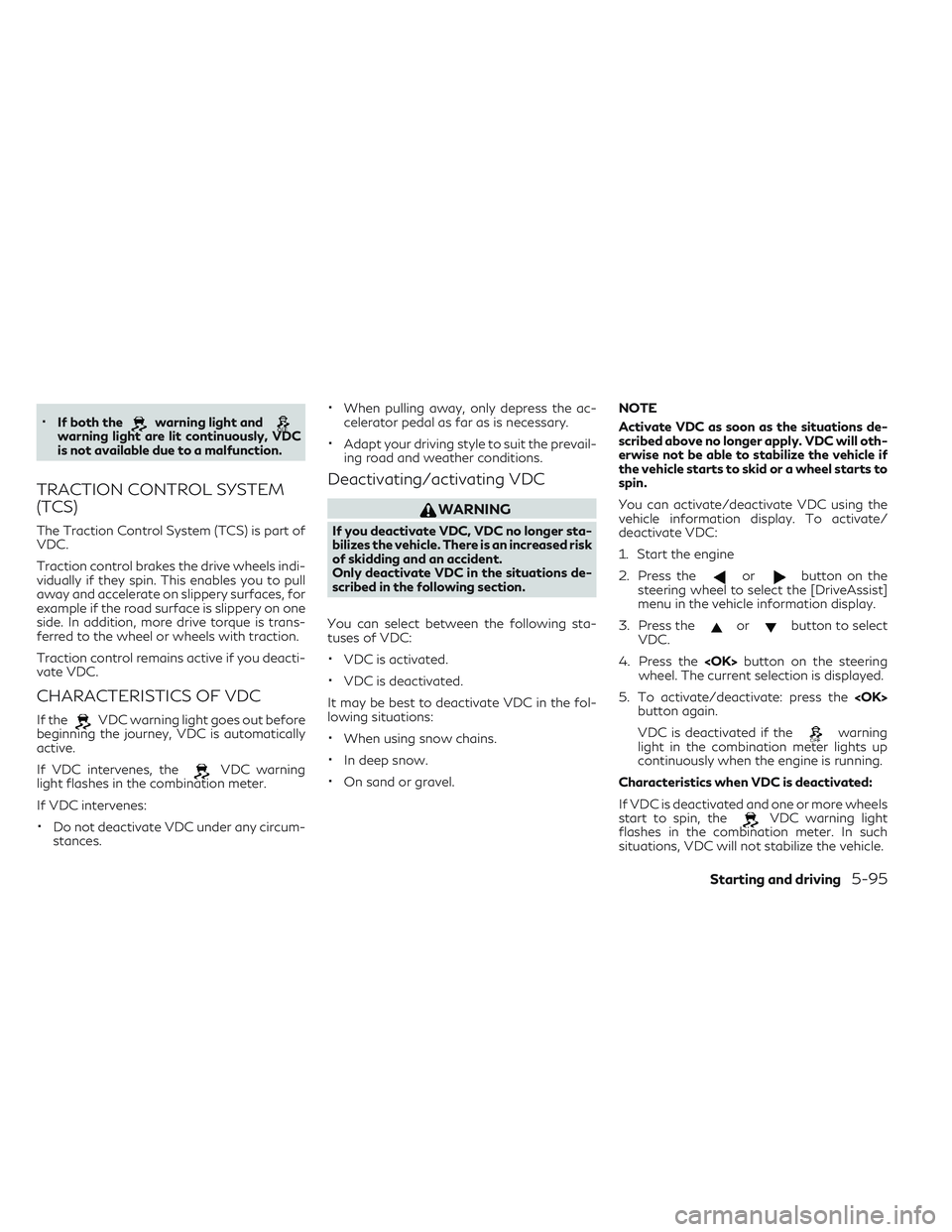
•If both thewarning light andwarning light are lit continuously, VDC
is not available due to a malfunction.
TRACTION CONTROL SYSTEM
(TCS)
The Traction Control System (TCS) is part of
VDC.
Traction control brakes the drive wheels indi-
vidually if they spin. This enables you to pull
away and accelerate on slippery surfaces, for
example if the road surface is slippery on one
side. In addition, more drive torque is trans-
ferred to the wheel or wheels with traction.
Traction control remains active if you deacti-
vate VDC.
CHARACTERISTICS OF VDC
If theVDC warning light goes out before
beginning the journey, VDC is automatically
active.
If VDC intervenes, the
VDC warning
light flashes in the combination meter.
If VDC intervenes:
•Do not deactivate VDC under any circum-
stances.
•When pulling away, only depress the ac-
celerator pedal as far as is necessary.
•Adapt your driving style to suit the prevail-
ing road and weather conditions.
Deactivating/activating VDC
WARNING
If you deactivate VDC, VDC no longer sta-
bilizes the vehicle. There is an increased risk
of skidding and an accident.
Only deactivate VDC in the situations de-
scribed in the following section.
You can select between the following sta-
tuses of VDC:
•VDC is activated.
•VDC is deactivated.
It may be best to deactivate VDC in the fol-
lowing situations:
•When using snow chains.
•In deep snow.
•On sand or gravel. NOTE
Activate VDC as soon as the situations de-
scribed above no longer apply. VDC will oth-
erwise not be able to stabilize the vehicle if
the vehicle starts to skid or a wheel starts to
spin.
You can activate/deactivate VDC using the
vehicle information display. To activate/
deactivate VDC:
1. Start the engine
2. Press the
orbutton on the
steering wheel to select the [DriveAssist]
menu in the vehicle information display.
3. Press the
orbutton to select
VDC.
4. Press the
wheel. The current selection is displayed.
5. To activate/deactivate: press the
button again.
VDC is deactivated if the
warning
light in the combination meter lights up
continuously when the engine is running.
Characteristics when VDC is deactivated:
If VDC is deactivated and one or more wheels
start to spin, the
VDC warning light
flashes in the combination meter. In such
situations, VDC will not stabilize the vehicle.
Starting and driving5-95
Page 427 of 538
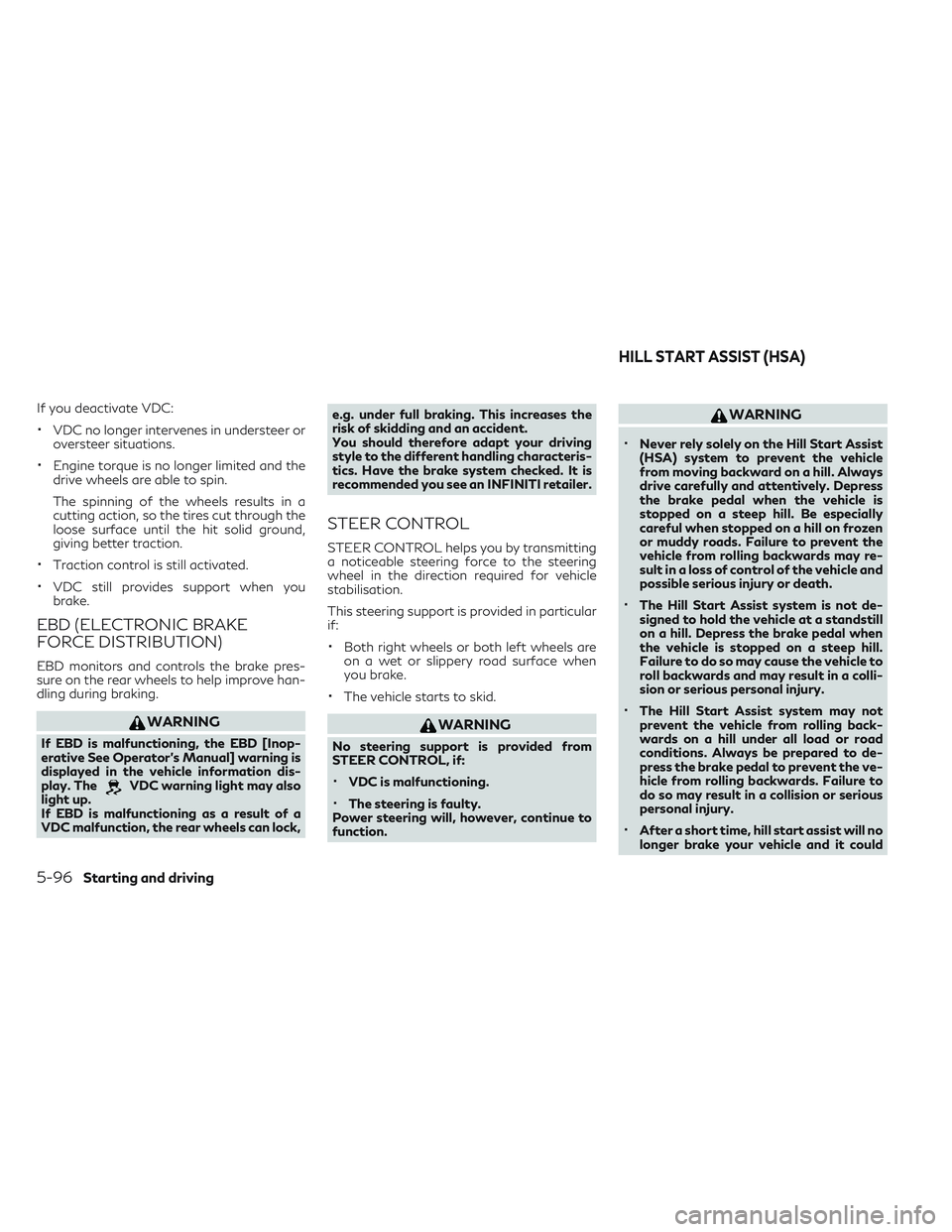
If you deactivate VDC:
•VDC no longer intervenes in understeer or
oversteer situations.
•Engine torque is no longer limited and the
drive wheels are able to spin.
The spinning of the wheels results in a
cutting action, so the tires cut through the
loose surface until the hit solid ground,
giving better traction.
•Traction control is still activated.
•VDC still provides support when you
brake.
EBD (ELECTRONIC BRAKE
FORCE DISTRIBUTION)
EBD monitors and controls the brake pres-
sure on the rear wheels to help improve han-
dling during braking.
WARNING
If EBD is malfunctioning, the EBD [Inop-
erative See Operator's Manual] warning is
displayed in the vehicle information dis-
play. The
VDC warning light may also
light up.
If EBD is malfunctioning as a result of a
VDC malfunction, the rear wheels can lock, e.g. under full braking. This increases the
risk of skidding and an accident.
You should therefore adapt your driving
style to the different handling characteris-
tics. Have the brake system checked. It is
recommended you see an INFINITI retailer.
STEER CONTROL
STEER CONTROL helps you by transmitting
a noticeable steering force to the steering
wheel in the direction required for vehicle
stabilisation.
This steering support is provided in particular
if:
•Both right wheels or both left wheels are
on a wet or slippery road surface when
you brake.
•The vehicle starts to skid.
WARNING
No steering support is provided from
STEER CONTROL, if:
•VDC is malfunctioning.
•The steering is faulty.
Power steering will, however, continue to
function.
WARNING
•Never rely solely on the Hill Start Assist
(HSA) system to prevent the vehicle
from moving backward on a hill. Always
drive carefully and attentively. Depress
the brake pedal when the vehicle is
stopped on a steep hill. Be especially
careful when stopped on a hill on frozen
or muddy roads. Failure to prevent the
vehicle from rolling backwards may re-
sult in a loss of control of the vehicle and
possible serious injury or death.
•The Hill Start Assist system is not de-
signed to hold the vehicle at a standstill
on a hill. Depress the brake pedal when
the vehicle is stopped on a steep hill.
Failure to do so may cause the vehicle to
roll backwards and may result in a colli-
sion or serious personal injury.
•The Hill Start Assist system may not
prevent the vehicle from rolling back-
wards on a hill under all load or road
conditions. Always be prepared to de-
press the brake pedal to prevent the ve-
hicle from rolling backwards. Failure to
do so may result in a collision or serious
personal injury.
•After a short time, hill start assist will no
longer brake your vehicle and it could
HILL START ASSIST (HSA)
5-96Starting and driving
Page 428 of 538

roll away There is a risk of an accident
and injury. Therefore, quickly move your
foot from the brake pedal to the accel-
erator pedal. Never leave the vehicle
when it is held by hill start assist.
Hill start assist helps you when pulling away
forwards or in reverse on an uphill gradient. It
holds the vehicle for a short time after you
have removed your foot from the brake
pedal. This gives you enough time to move
your foot from the brake pedal to the accel-
erator pedal and depress it before the vehicle
begins to roll.
Hill start assist is not active if
•You are pulling away on a level road or a
downhill gradient.
•On vehicles with automatic transmission,
the transmission is in position N.
•The electric parking brake is applied.
•VDC is malfunctioning.
FREEING A FROZEN DOOR LOCK
To prevent a door lock from freezing, apply
deicer through the key hole. If the lock be-
comes frozen, heat the key before inserting it
into the key hole, or use the INFINITI Intelli-
gent Key.
ANTIFREEZE
In the winter when it is anticipated that the
temperature will drop below 32°F (0°C),
check the antifreeze to assure proper winter
protection. For additional information, see
"Engine cooling system" in the "8. Do-it-
yourself" section.
BATTERY
If the battery is not fully charged during ex-
tremely cold weather conditions, the battery
fluid may freeze and damage the battery. To
maintain maximum efficiency, the battery
should be checked regularly. For details, see
"Battery" in the "8. Do-it-yourself" section of
this manual.
DRAINING OF ENGINE COOLANT
If the vehicle is to be left outside without
antifreeze, drain the cooling system, including
the engine block. Refill before operating the
vehicle. For details, see "Changing engine
coolant" in the "8. Do-it-yourself" section of
this manual.
TIRE EQUIPMENT
1. SUMMER tires have a tread designed to provide superior performance on dry
pavement. However, the performance of
these tires will be substantially reduced in
snowy and icy conditions. If you operate
your vehicle on snowy or icy roads,
INFINITI recommends the use of MUD &
SNOW or ALL SEASON TIRES on all four
wheels. It is recommended that you visit
an INFINITI retailer for the tire type, size,
speed rating and availability information.
2. For additional traction on icy roads, stud- ded tires may be used. However, some
U.S. states and Canadian provinces pro-
hibit their use. Check local, state and pro-
vincial laws before installing studded tires.
Skid and traction capabilities of studded
snow tires, on wet or dry surfaces, may be
poorer than that of non-studded snow tires.
3. Tire chains may be used if desired. Make sure they are the proper size for the tires
on your vehicle and are installed according
to the chain manufacturer’s instructions.
Use chain tensioners when recommended
by the tire chain manufacturer to ensure a
tight fit. Loose end links of the tire chains
must be secured or removed to prevent
the possibility of whipping action damage
to the fenders or underbody. In addition,
COLD WEATHER DRIVING
Starting and driving5-97
Page 429 of 538

drive at a reduced speed, otherwise, your
vehicle may be damaged and/or vehicle
handling and performance may be ad-
versely affected.
SPECIAL WINTER EQUIPMENT
It is recommended that the following items
be carried in the vehicle during the winter:
•A scraper and stiff-bristled brush to re-
move ice and snow from the windows.
•A sturdy, flat board to be placed under the
jack to give it firm support.
•A shovel to dig the vehicle out of snow-
drifts.
•Extra washer fluid to refill the windshield
washer fluid reservoir.
DRIVING ON SNOW OR ICE
WARNING
•Wet ice (32°F, 0°C and freezing rain),
very cold snow or ice can be slick and
very hard to drive on. The vehicle will
have much less traction or “grip” under
these conditions. Try to avoid driving on
wet ice until the road is salted or sanded.
•Whatever the condition, drive with cau-
tion. Accelerate and slow down with
care. If accelerating or downshifting too
fast, the drive wheels will lose even more
traction.
•Allow more stopping distance under
these conditions. Braking should be
started sooner than on dry pavement.
•Allow greater following distances on
slippery roads.
•Watch for slippery spots (glare ice).
These may appear on an otherwise clear
road in shaded areas. If a patch of ice is
seen ahead, brake before reaching it. Try
not to brake while on the ice, and avoid
any sudden steering maneuvers.
•Do not use cruise control on slippery
roads.
•Snow can trap dangerous exhaust gas
under your vehicle. Keep snow clear of
the exhaust pipe and from around your
vehicle.
5-98Starting and driving
Page 430 of 538

6 In case of emergency
Hazard warning flasher switch.............6-2
Flat tire ........................... .6-2
Tire Pressure Monitoring System (TPMS) .....6-2
Stopping vehicle .................... .6-3
Warning triangle (if equipped) ............6-4
Run-flat tires ...................... .6-4Removing and fitting wheels
.............6-5
Jump starting ...................... .6-10
Push starting ....................... .6-12
If your vehicle overheats ................ .6-13
Towing your vehicle .................. .6-14
Towing recommended by INFINITI ........6-14